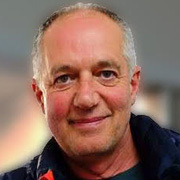
John Hagen
John Hagen was an army kid. Born in Stratford, he ended up in Trentham, Upper Hutt after his Dutch dad transferred into the New Zealand Army. Music was an early love: Hagen played trumpet in the National Youth Orchestra, but he got his real kicks moonlighting in a soul band. He joined the Air Force, but soon realised bowing to authority wasn’t for him.
In the mid 70s an editor at the newly opened Avalon television studios suggested he bowl along — Avalon needed more sound recordists. Hagen took his advice, and landed in “a dream job”.
"We were all learning how to make TV together. Pamela Meeking-Stewart was a mentor of mine and she had a saying, ‘fake it till you make it’.” Meeking-Stewart was one of a collection of "strong, inspirational women" that influenced Hagen in his early days. It was Avalon's heyday, when wandering past the Grunt Machine studio could provide a free mind-altering experience. “God what we did to ourselves," he laughs. "I didn’t think I was going to make it past 40”.
Hagen recorded sound for programmes like Inside Straight and Pioneer Women, plus lots of fast turnaround, local dramas including The Fire-Raiser (1986). His boss John Carpenter imbued him with the confidence to speak up on set. “I was a bit shy then. I learnt, like actors, that you could invent a persona and make your voice heard.”
He also taught scuba diving in his spare time. “There was a diving course for disabled students and I thought it’d be a great topic for a doco. I’d seen a lot of directors by now — good and bad — and I thought 'hell I’ll dive in'”.
He secured funding and sought leave from Avalon to make The Deep End. The decision to deny him leave inspired Hagen to resign immediately, and call himself a director. Hagen learnt as he went. One early highlight was series Work of Art. His piece profiled Kiwi corrugated iron ‘specialist’ Jeff Thomson. Hagen decided to go for broke, asking legendary cinematographer Alun Bollinger on board as well as Don McGlashan, who improvised music from the images.
In the 90s Hagen joined the team at Ninox Films in Wellington. Ninox boss David Harry Baldock "backed his directors 100 per cent”. Hagen met then writer/researcher Gary Scott, who worked with him on top-rating documentary The Great Kiwi Pub. Ninox introduced an idea that would set the template for hits like The Block: two families competing to build a a new home. Hagen directed the first season of Mitre 10 Dream Home. He remembers staring out the plane window en route to Blenheim, the first location, and “wondering how the hell we'd make this show”.
Gary Scott was now producing for Gibson Group, and asked Hagen on board for episodes of documentary series Kiwis at War (2006), and Here to Stay (2007-2008), in which Kiwi personalities chronicled key settler groups to New Zealand. At the 2007 Qantas awards, Hagen was a finalist in the Best Director category, for Here to Stay's debut episode. Hagen had already worked with Gibsons on one-off Anzac Day documentary Dare to be Free (one of the highest-rating programmes of 2004), and weekly arts show Frontseat — produced by another inspirational woman, Gemma Gracewood. Hagen loved his remit, presenting stories in interesting and beautiful ways.
After 2007 Hagen moved to Auckland. He directed Saving Face for Top Shelf Productions, which chronicled the pioneering plastic surgery of Sir Harold Gillies and Henry Pickerill during WW1. The same year producer Gracewood got Hagen on board for ambitious arts series New Artland, which screened on digital channel TVNZ 7. The presenter was legendary musician and whiskey connoisseur Chris Knox.
In 2010 Hagen directed A Rotten Shame, which looked at the financial and emotional damage the ‘leaky building’ scandal had on Auckland homeowners. It was a finalist in the Investigation of the Year category of the AFTA awards.
At the last minute Hagen jumped into directing episodes of TVNZ series First Crossings. The experience ranks among his most satisfying to date. His crew and presenters Kevin Biggar and Jamie Fitzgerald travelled to remote and stunning New Zealand landscapes to recreate early explorers’ incredible feats. “ It was another pinch yourself moment”.
In 2016 he directed on-the-road series The New Zealand Home, visiting original Kiwi buildings alongside the show's presenters, Goran Paladin and architect Ken Crossan. On website Stuff, Colleen Hawkes called it “a must-watch”. Hagen's next trip saw him "recreating" pioneering TV figure Shirley Maddock’s series Islands of the Gulf. This time the presenter is Maddock’s daughter: writer and actor Elisabeth Easther.
He went on to chronicle a downunder trip by Welsh comedian Griff Rhys-Jones, as one of the directors of series Griff's Great Kiwi Road Trip.
Profile written by Gabe McDonnell; updated on 8 August 2020
Sources include
John Hagen
John Hagen website. Accessed 8 August 2020
Colleen Hawkes, 'The NZ Home; the new series on our architectural history is right on track' Stuff website. Loaded 8 July 2016. Accessed 26 April 2017
Ian Pryor, 'Gary Scott' NZ On Screen website. Accessed 26 April 2017
Saving Face (Television Documentary) Director John Hagen (Top Shelf Productions, 2009)
Frontseat (Television Documentary) Various Directors (Gibson Group, 2004 - 2007)